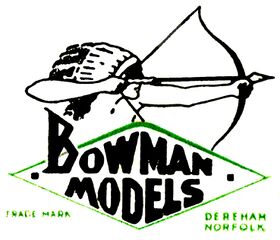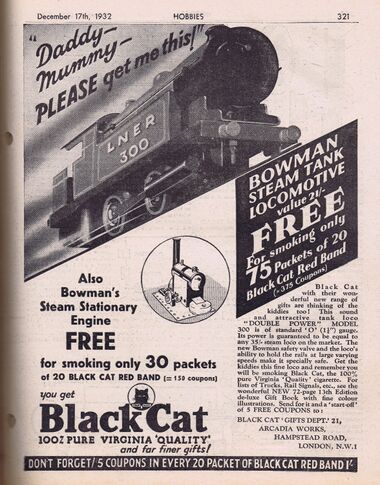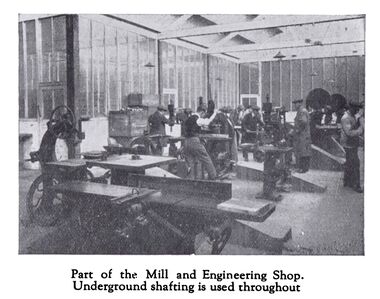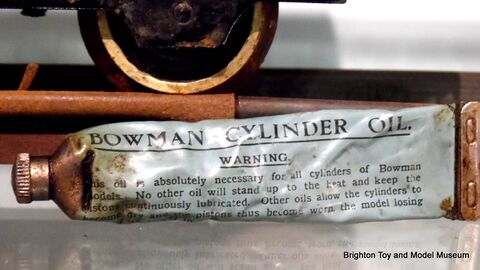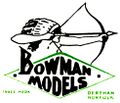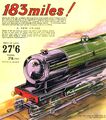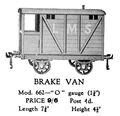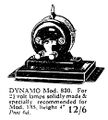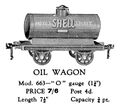Category:Bowman Models: Difference between revisions
(+ Bowman catalogue text) |
m (Text replacement - "{{#seo:" to "{{#SEO:") |
||
| (28 intermediate revisions by the same user not shown) | |||
| Line 1: | Line 1: | ||
{{Toymaker}} | {{#SEO: |title=Bowman Models (1926-~1950), Geoffrey Bowman Jenkins, Dereham, Norfolk}} | ||
{{Toymaker|Bowman_Models_logo.jpg|Bowman_Models,_logo,_bow-shape.jpg|Bowman_Models,_cover.jpg|Date1=1926|Date2=~1950}} | |||
{{Box|Bowman_Book_of_Steam_Models,_cover_(~1931).jpg|Bowman Book of Steam Models (~1931?)|380}} | |||
{{Box|Use_Steam,_Bowman_Models_(HW_1932-11-12).jpg|1932: "USE STEAM!", Bowman Models range, Hobbies magazine|380}} | |||
{{Box|Bowman_Models,_catalogue_cover.jpg|Bowman models catalogue cover, undated|380}} | |||
{{Box|Bowman_LNER_300,_Black_Cat_Cigarettes_(HW_1932-12-017).jpg|1932: Bowman model 300 locomotive and stationary steam engine, Black Cat cigarette coupon promotion|380}} | |||
{{Box|Bowman_Models,_Mill_and_Engineering_Shop_(BowmanCat_~1931).jpg|~1931: "Part of the Mill and Engineering Shop. Underground shafting is used throughout"|380}} | |||
{{Box|Bowman_Models,_Assembly_Department_(BowmanCat_~1931).jpg|~1931: "Assembly Department. Every model is assembled, tested and inspected before packing"|380}} | |||
{{Box|Bowman_Models,_Soldering_and_Boiler_Testing_Shop_(BowmanCat_~1931).jpg|~1931: "Part of Soldering and Boiler Testing Shop. All soldered joints are tested before and after assembling"|380}} | |||
{{Box|Bowman_Models,_Painting_and_Laquering_Shop_(BowmanCat_~1931).jpg|~1931: "Corner of Painting and Lacquering Shop. Throughout these processes special heat resisting paints are used."|380}} | |||
'''Bowman Models''' of Dereham, Norfolk, England (Directors: '''Geoffrey Bowman Jenkins''', '''Bernard A. Smart'''), was founded in 1926, and made a range of steam-powered models between the Wars, some of which are on display in the museum's "Toyshop Steam" cabinet, with accompanying literature. Jenkins supplied models and engines to Hobbies from around 1923 to ~1935, and then "went independent". Gamages advertised having bought up liquidated stock of Bowman engines in 1950-51, so presumably the company finished some time around then. | |||
{{BigPic|The_Bowman_Book_of_Steam_Models,_cover_(1931).jpg|1931: The Bowman Book of Steam Models}} | |||
==Development== | |||
Jenkins had started selling toys in London ... when Hobbies' had to stop using their original German suppliers of steam engines, a search brought Bowman to their attention, and he was persuaded to move up to to Norfolk in around ~1923, and assemble boats and manufacture steam engines that Hobbies could then advertise and sell through [[Hobbies Weekly]]. | |||
Initially the results of the joint venture tended to be sold as '''Hobbies''' products, then marketed under the name '''Hobbies-Bowman''', and finally as just '''Bowman Models''' products, with the new name established in 1926. | |||
Bowman seems to have parted company with Hobbies in or by 1935 in order to pursue other manufacturing interests (including a spring-powered gramophone, at which point Hobbies brought in '''Geoffrey Malins''' ('''Malins Models''', '''[[Mamod]]''') as a replacement. | |||
Bowman's | ==Range== | ||
The use of functional steam power meant that Bowman's core range wasn't huge, and their steam-powered pieces were engineered for simplicity and reliability, with a minimum of "fancy" ornamentation. As well as producing stationary steam engines for driving [[Meccano]] models, the company also produced steam locomotives, rolling stock, rubber-band-powered model aeroplanes, and clockwork, rubber-drive and steam-powered speedboats. | |||
{{BigPic|Bowman_Cylinder_Oil_tube.jpg|A tube of Bowman Cylinder Oil}} | |||
== | ==Bowmans Models of Luton== | ||
After World War Two, P.M Nash's '''Piece Parts and Assemblies Ltd.''' company needed to find a new market now that they were no longer getting a steady steam of contracts related to war work, and acquired the Bowman Models name and trademark. The company then produced their own range of Meccano-compatible steam engines and other products similar to those in the original Bowman Models range. However, to most people "Bowman Models" means Geoffrey Bowman Jenkins' original company. | |||
== | ==In the museum== | ||
The [[Bowman 410 steam model locomotive|Model 410]] and [[Bowman 234 steam model locomotive|Model 234]] steam locos on display in the [[Toyshop Steam]] cabinet represent the smallest and the largest steam locomotive models produced by Bowman. | |||
== | ==See also:== | ||
* '''[[:Category: Mamod|Mamod]]''' | |||
: | |||
: | {{links}} | ||
* [http://www.odilon.0fees.net/styled/ Bowman Models, Mooseman (odilon.0fees.net)] | |||
* [http://www.gracesguide.co.uk/Bowman_Models Bowman Models, Grace's Guide (gracesguide.co.uk)] | |||
* [http://www.bowmancircle.co.uk/page7.php Bowman information (bowmancircle.co.uk)] | |||
=== | * [https://worldwide.espacenet.com/publicationDetails/biblio?FT=D&date=19310212&DB=EPODOC&locale=en_EP&CC=GB&NR=342992A&KC=A&ND=4 Patent GB342992 (A) ― 1931-02-12 – Improvements in the method of building up hulls for model and toy boats (espacenet.com)] | ||
: | =====Bowman Models of Luton:===== | ||
* [http://www.freewebs.com/odilon/styled-4/ Bowman of Luton (freewebs.com)] | |||
{{Hobbies}} | |||
{{GardenRailway}} | |||
{{ | |||
Latest revision as of 10:10, 7 July 2022
| Toy Brands and Manufacturers |
|---|
Bowman Models |
| 1926 - ~1950 |
Bowman Book of Steam Models (~1931?) [image info]
1932: "USE STEAM!", Bowman Models range, Hobbies magazine [image info]
Bowman models catalogue cover, undated [image info]
1932: Bowman model 300 locomotive and stationary steam engine, Black Cat cigarette coupon promotion [image info]
~1931: "Part of the Mill and Engineering Shop. Underground shafting is used throughout" [image info]
~1931: "Assembly Department. Every model is assembled, tested and inspected before packing" [image info]
~1931: "Part of Soldering and Boiler Testing Shop. All soldered joints are tested before and after assembling" [image info]
~1931: "Corner of Painting and Lacquering Shop. Throughout these processes special heat resisting paints are used." [image info]
Bowman Models of Dereham, Norfolk, England (Directors: Geoffrey Bowman Jenkins, Bernard A. Smart), was founded in 1926, and made a range of steam-powered models between the Wars, some of which are on display in the museum's "Toyshop Steam" cabinet, with accompanying literature. Jenkins supplied models and engines to Hobbies from around 1923 to ~1935, and then "went independent". Gamages advertised having bought up liquidated stock of Bowman engines in 1950-51, so presumably the company finished some time around then.
Development
Jenkins had started selling toys in London ... when Hobbies' had to stop using their original German suppliers of steam engines, a search brought Bowman to their attention, and he was persuaded to move up to to Norfolk in around ~1923, and assemble boats and manufacture steam engines that Hobbies could then advertise and sell through Hobbies Weekly.
Initially the results of the joint venture tended to be sold as Hobbies products, then marketed under the name Hobbies-Bowman, and finally as just Bowman Models products, with the new name established in 1926.
Bowman seems to have parted company with Hobbies in or by 1935 in order to pursue other manufacturing interests (including a spring-powered gramophone, at which point Hobbies brought in Geoffrey Malins (Malins Models, Mamod) as a replacement.
Range
The use of functional steam power meant that Bowman's core range wasn't huge, and their steam-powered pieces were engineered for simplicity and reliability, with a minimum of "fancy" ornamentation. As well as producing stationary steam engines for driving Meccano models, the company also produced steam locomotives, rolling stock, rubber-band-powered model aeroplanes, and clockwork, rubber-drive and steam-powered speedboats.
Bowmans Models of Luton
After World War Two, P.M Nash's Piece Parts and Assemblies Ltd. company needed to find a new market now that they were no longer getting a steady steam of contracts related to war work, and acquired the Bowman Models name and trademark. The company then produced their own range of Meccano-compatible steam engines and other products similar to those in the original Bowman Models range. However, to most people "Bowman Models" means Geoffrey Bowman Jenkins' original company.
In the museum
The Model 410 and Model 234 steam locos on display in the Toyshop Steam cabinet represent the smallest and the largest steam locomotive models produced by Bowman.
See also:
External links
- Bowman Models, Mooseman (odilon.0fees.net)
- Bowman Models, Grace's Guide (gracesguide.co.uk)
- Bowman information (bowmancircle.co.uk)
Bowman Models of Luton:
Subcategories
This category has the following 13 subcategories, out of 13 total.
A
- Aeroboats (Bowman Models) (4 F)
- Bowman model aeroplanes (5 F)
B
C
- Bowman clockwork boats (7 F)
E
- Bowman Electric Motors and Dynamos (1 P, 7 F)
M
- Bowman miscellaneous (4 F)
R
- Bowman model railways (5 P, 21 F)
S
- Bowman live steam boats (7 P, 21 F)
W
- Bowman Working Models (10 F)
- Wormar stationary steam engines (3 P, 12 F)
Pages in category ‘Bowman Models’
The following 13 pages are in this category, out of 13 total.
Media in category ‘Bowman Models’
The following 115 files are in this category, out of 115 total.
- Aeroboat II, Bowman Models (MM 1931-05).jpg 2,380 × 1,509; 391 KB
- Aeroboats, Bowman Models (HW 1931-05-23).jpg 1,600 × 1,105; 953 KB
- Aeroboats, Bowman Models (HW 1932-05-07).jpg 1,600 × 1,079; 1.01 MB
- Aeroboats, Bowman Models (HW 1932-06-11).jpg 1,600 × 1,065; 1.01 MB
- Bandsaw, Working Model (Bowman Model 834).jpg 862 × 1,132; 250 KB
- Bowman advert - Be a real engineer.jpg 1,200 × 1,626; 327 KB
- Bowman Aeroplanes beat all rivals, Hobbies (HW 1932-04-09).jpg 664 × 1,600; 282 KB
- Bowman Boats (MM 1933-09).jpg 942 × 1,800; 468 KB
- Bowman Book for Boys, cover.jpg 1,603 × 2,200; 2.03 MB
- Bowman Book of Steam Models 1932 (HW 1931-12-12).jpg 640 × 420; 168 KB
- Bowman Book of Steam Models, cover (~1931).jpg 2,000 × 1,437; 481 KB
- Bowman carriage 17172 detail.jpg 1,600 × 1,200; 1.05 MB
- Bowman Chemistry Sets.jpg 1,326 × 1,800; 852 KB
- Bowman Comet (MM 1933-06).jpg 1,184 × 813; 185 KB
- Bowman Cylinder Oil tube.jpg 1,600 × 901; 963 KB
- Bowman Electrical Sets.jpg 1,166 × 1,800; 891 KB
- Bowman LNER 300, Black Cat Cigarettes (HW 1932-12-017).jpg 2,351 × 3,000; 2.09 MB
- Bowman Loco 234 (MM 1934-10).jpg 2,181 × 1,309; 320 KB
- Bowman Loco 234 running instructions, pages 1, 4 (Bowman Models).jpg 1,800 × 1,369; 1.81 MB
- Bowman Loco 234 running instructions, pages 2-3 (Bowman Models).jpg 1,800 × 1,369; 1.93 MB
- Bowman Loco 234.jpg 1,086 × 672; 103 KB
- Bowman Models logo.jpg 982 × 840; 87 KB
- Bowman Models, 183 Miles, artwork.jpg 2,207 × 2,500; 4.21 MB
- Bowman Models, Assembly Department (BowmanCat ~1931).jpg 2,149 × 1,696; 1.82 MB
- Bowman Models, catalogue cover.jpg 1,751 × 2,000; 2.54 MB
- Bowman Models, cover.jpg 1,200 × 331; 173 KB
- Bowman Models, logo, bow-shape.jpg 1,200 × 795; 411 KB
- Bowman Models, Mill and Engineering Shop (BowmanCat ~1931).jpg 2,151 × 1,694; 1.76 MB
- Bowman Models, Painting and Laquering Shop (BowmanCat ~1931).jpg 2,149 × 1,684; 1.81 MB
- Bowman Models, Soldering and Boiler Testing Shop (BowmanCat ~1931).jpg 2,149 × 1,676; 1.74 MB
- Bowman Patent Steel Track (BowmanCat ~1931).jpg 2,200 × 1,517; 1.05 MB
- Bowman Patent Steel Track.jpg 1,800 × 1,311; 735 KB
- Bowman Safety Valve, graphic (BowmanCat ~1931).jpg 1,263 × 1,263; 406 KB
- Bowman Snipe speedboat, detail.jpg 1,600 × 904; 833 KB
- Bowman Steam Engines, Gamages (MM 1950-10).jpg 1,536 × 1,053; 589 KB
- Bowman Steam-Powered Workshop, Bowman Models publicity photo (BowmanCat ~1931).jpg 2,295 × 1,275; 1.36 MB
- Bowman Table Tennis.jpg 1,457 × 1,800; 850 KB
- Bowmans Models, Be a Real Engineer (MM 1934-10).jpg 1,605 × 2,071; 542 KB
- Brake Van, Bowman Models 662 (BowmanCat ~1931).jpg 1,358 × 1,309; 545 KB
- Circular Saw, Working Model (Bowman Model 833).jpg 838 × 991; 246 KB
- Clockwork Boat, Bowman Models (Hobbies 1933).jpg 2,000 × 853; 554 KB
- Clockwork Boat, Hobbies, Bowman (Hobbies 1930).jpg 2,500 × 1,104; 1.22 MB
- Clockwork Launch, Hobbies (HW 1930-04-05).jpg 2,200 × 1,860; 1.45 MB
- Comet clockwork speedboat, Swift as a Comet, Bowman Models (MM 1933-06).jpg 1,600 × 1,077; 683 KB
- Demon stationary engine (Hobbies 1930).jpg 1,600 × 768; 433 KB
- Demon Steam Engine, Hobbies (HW 1930-09-20).jpg 3,000 × 2,121; 1.86 MB
- Drill, Working Model (Bowman Model 837).jpg 859 × 1,377; 267 KB
- Dynamo, Steam Powered (Bowman Model 130).jpg 1,800 × 1,026; 605 KB
- Dynamo, Working Model (Bowman Model 830).jpg 936 × 1,042; 271 KB
- Eagle Steam Speedboat, Hobbies-Bowman (BBoSM ~1931).jpg 3,000 × 2,076; 1.78 MB
- Eagle Super Motor Launch, The Real Thing, Hobbies-Bowman (HW 1930-08-23).jpg 1,800 × 1,319; 915 KB
- Express Passenger Train Set, Bowman Models 23455 (BowmanCat ~1931).jpg 3,000 × 967; 826 KB
- Firefly rubber-driven boat (Hobbies 1933).jpg 2,000 × 738; 572 KB
- Fretsaw, Working Model (Bowman Model 836).jpg 827 × 923; 215 KB
- Goods Train Set, Bowman Models 26566 (BowmanCat ~1931).jpg 3,000 × 1,181; 963 KB
- Grindstone, Working Model (Bowman Model 831).jpg 825 × 1,133; 248 KB
- Grindstone, Working Model (Bowman Model 835).jpg 804 × 931; 194 KB
- Halfords full-page advert (MM 1933-07).jpg 1,512 × 2,000; 523 KB
- Hercules stationary engine construction set (Hobbies 1930).jpg 1,600 × 1,098; 777 KB
- Hercules stationary engine construction set (Hobbies 1932).jpg 2,200 × 1,360; 1.19 MB
- Hipower Water Motor (Bowman Model 860).jpg 2,200 × 1,939; 1.24 MB
- Hobbies Clockwork Launch (HW 1931-07-04).jpg 2,000 × 1,292; 1,000 KB
- Hobbies-Bowman Boat Fortnight, Prize Scheme (HW 1932-07-23).jpg 2,000 × 1,313; 1.08 MB
- Junior Tank Loco (Bowman Model 410).jpg 2,660 × 2,124; 1.33 MB
- Lion stationary steam engine kits (Hobbies 1933).jpg 3,794 × 1,615; 1.18 MB
- Lion stationary steam engine, colour (Hobbies 1930).jpg 2,270 × 3,000; 2.88 MB
- LNER Passenger Coach 11652, Bowman Models 551 (BowmanCat ~1931).jpg 2,903 × 1,985; 1.65 MB
- Marine Engine, Bowman Models (Hobbies 1933).jpg 1,921 × 1,717; 765 KB
- Miss America Steam Launch, Hobbies, Bowman (Hobbies 1930).jpg 2,500 × 1,122; 1.09 MB
- Model Boats at reduced prices, Hobbies (HW 1931-04-11).jpg 2,000 × 1,345; 1.19 MB
- Now for the Yacht Pond, Hobbies steam launches, graphic (HW 1930-06-28).jpg 2,000 × 1,208; 717 KB
- Open Wagon, Bowman Models 661 (BowmanCat ~1931).jpg 1,316 × 1,045; 381 KB
- Peggy Steam Launch, Hobbies, Bowman (Hobbies 1930).jpg 2,500 × 1,248; 1.19 MB
- Peggy Steam Launch, superheated, Hobbies, Bowman (Hobbies 1930).jpg 2,500 × 1,291; 1.33 MB
- Peggy superheated steam launch, Bowman Models (Hobbies 1933).jpg 2,000 × 858; 715 KB
- Pioneer Steam Launch, superheated, Hobbies, Bowman (Hobbies 1930).jpg 2,500 × 1,250; 1.37 MB
- Press, Working Model (Bowman Model 832).jpg 812 × 1,107; 231 KB
- Realistic Garden Railway, Bowman Models publicity photo (BowmanCat ~1931).jpg 2,288 × 1,545; 1.78 MB
- Seahawk steam powerboat, Bowman (HW 1931-07-25).jpg 2,000 × 1,361; 1.4 MB
- Seahawk Steam Speedboat, Bowman (Hobbies 1932).jpg 2,500 × 1,106; 1.31 MB
- Seahawk Steam Speedboat, Hobbies-Bowman (BBoSM ~1931).jpg 3,000 × 2,267; 2.23 MB
- Shafting, Working Model (Bowman Model 838).jpg 877 × 812; 206 KB
- Shell Motor Spirit Oil Wagon, Bowman Models 663 (BowmanCat ~1931).jpg 1,346 × 1,205; 441 KB
- Shell Oil Tanker (Bowman Models 663).jpg 1,200 × 900; 711 KB
- Snipe model racing motor boat (Bowman Models), Gamages (GamCat 1932).jpg 2,279 × 1,414; 1.1 MB
- Snipe speedboat, Bowman (MM 1931-05).jpg 2,340 × 1,557; 621 KB
- Snipe steam racing boat, Bowman Models (HW 1931-06-27).jpg 2,000 × 1,395; 1.27 MB
- Snipe Steam Speedboat, Hobbies-Bowman (BBoSM ~1931).jpg 3,000 × 2,142; 1.85 MB
- Stationary Engine (Bowman Model 158).jpg 1,800 × 1,257; 658 KB
- Stationary Engine (Bowman Model M175).jpg 1,800 × 1,056; 524 KB
- Stationary Engine (Bowman Model M180).jpg 1,800 × 1,099; 627 KB
- Stationary Steam Engine, Bowman Models 101 (BowmanCat ~1931).jpg 3,000 × 2,309; 1.89 MB
- Stationary Steam Engine, Bowman Models 122 (BowmanCat ~1931).jpg 3,000 × 2,251; 1.94 MB
- Stationary Steam Engine, Bowman Models 135 (BowmanCat ~1931).jpg 3,000 × 2,485; 2.37 MB
- Stationary Steam Engine, Bowman Models 140 (BowmanCat ~1931).jpg 3,000 × 2,556; 2.39 MB
- Stationary Steam Engine, Bowman Models 158 (BowmanCat ~1931).jpg 3,000 × 2,484; 1.92 MB
- Stationary Steam Engine, Bowman Models 167 (BowmanCat ~1931).jpg 3,000 × 2,552; 1.92 MB
- Steam 0-4-0 Tank Locomotive, Bowman Models 265 (BowmanCat ~1931).jpg 3,000 × 2,246; 2.27 MB
- Steam 0-4-0 Tank Locomotive, Bowman Models 300 (BowmanCat ~1931).jpg 3,000 × 2,246; 1.99 MB
- Steam 4-4-0 Express Locomotive, Bowman Models 234 (BowmanCat ~1931).jpg 3,000 × 2,311; 2.92 MB
- Swallow and Snipe Launches, Hobbies Bowman (HW 1930-07-26).jpg 825 × 1,200; 244 KB
- Swallow Speedboat, Hobbies-Bowman (BBoSM ~1931).jpg 2,500 × 1,473; 1.17 MB
- Swallow Steam Speedboat, Bowman (Hobbies 1932).jpg 2,500 × 1,115; 1.26 MB
- Swallow Steam Speedboats, Speed Speed Speed, Bowman Models (MM 1933-07).jpg 3,000 × 1,982; 1.96 MB
- The Bowman Book of Steam Models, cover (1931).jpg 2,500 × 1,710; 3.33 MB
- The Down Express, Bowman Models publicity photo (BowmanCat ~1931).jpg 2,350 × 1,808; 1.88 MB
- Tiger clockwork boat, Bowman Models (Hobbies 1933).jpg 2,000 × 758; 524 KB
- Timber Wagon, Bowman Models 664 (BowmanCat ~1931).jpg 1,320 × 1,045; 349 KB
- Two Boys with Bowman live steam boat, lineart (HW 1930-07-12).jpg 1,600 × 1,240; 666 KB
- Use Steam, Bowman Models (HW 1932-11-12).jpg 1,703 × 2,200; 1,023 KB
- Vulcan rubber band plane, Bowman Aeroplanes (Hobbies 1933).jpg 3,000 × 1,428; 1.75 MB
- Whirlwind racing boat, Bowman Models (HW 1932-08-20).jpg 1,800 × 646; 949 KB
- Whirlwind Rubber-powered Boat, Bowman (GamCat 1932).jpg 1,200 × 412; 148 KB
- Yachts and Launches, p1-2, Hobbies (HW 1930-06-28).jpg 1,800 × 1,349; 751 KB
